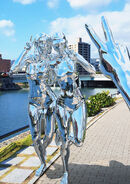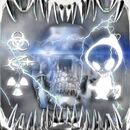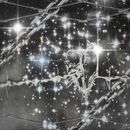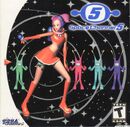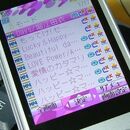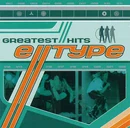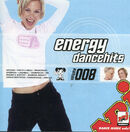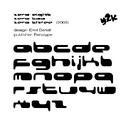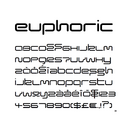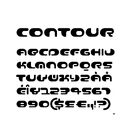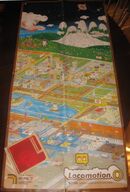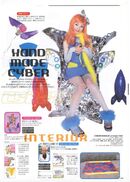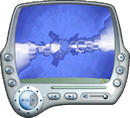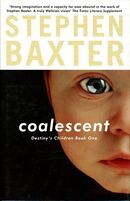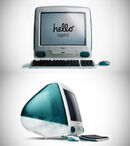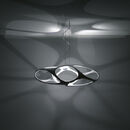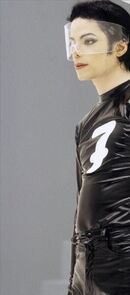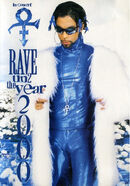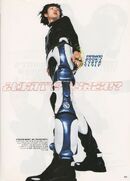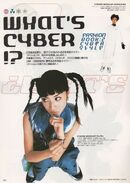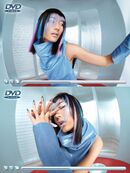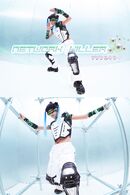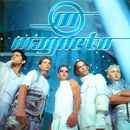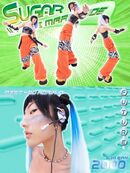Cybercore (also known as Cyber Y2K or Y3K, and originally just Y2K prior to semantic shift) is an aesthetic that was prevalent in popular culture from roughly 1997 to 2004, succeeding the Memphis Design and Grunge eras and overlapping with the McBling, UrBling, Surf Crush, and 2K1 aesthetics. Some of its aspects include tight leather pants, shiny clothing, silver eye shadow, spiky up-dos, Oakleys, gradients, translucence, and Blobitecture. Cybercore relies on the use of technology and slick futuristic looks, signaling the optimism for the 3rd Millennium or 21st Century.
Cybercore is mostly classified as a subcategory to Retro-Futurism, but some elements also cross over with Vaporwave, since it shares Vaporwave's angst towards late-stage capitalism, and its nostalgia for “a future that never came.”
History[]
Cybercore has its origins in the underground UK rave scene of the late '80s/Early '90s (i.e. The Prodigy, Aphex Twin, The Future Sound of London), as well as the early works of the Sheffield-based Designers Republic. The first signs of the Cybercore aesthetic going mainstream appeared around 1995 to 1996, with the release of Windows 95, the start of the Internet boom, the original PlayStation and Nintendo 64 being released with games such as Wipeout and Super Mario 64, Pokémon being released in Japan, the films Hackers, Trainspotting, and Scream being released, artists like the Spice Girls, Robyn, Moloko, and Backstreet Boys debuting in Europe, and the music video for Michael and Janet Jackson's "Scream". Campaigns like Nintendo's "Play It Loud" era might have been a precursor to Cybercore, as well.
Visuals[]
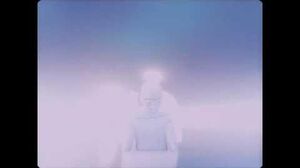
Ivy Hollivana – Dear Deathwaters (2019)
Perhaps the future of the Y2K Sound?
Graphics and Art[]
Cybercore aesthetics use both graphic design and CGI. Graphic designs usually feature thick lines, bold minimalism, and heavy use of iconography. CGI art is more blobby looking, having more gradients in contrast to Metalheart or Chromecore. Common colors used in Cybercore art are, but not limited to, chrome, icy blue, ocean, bright oranges, glossy white, and black (for linework).
One of the earliest definers of the Cybercore aesthetic is the Designers Republic, a Sheffield-based graphic design studio best known for their work on the video game series Wipeout as well as various album artwork, especially for artists on the electronica label Warp Records. Founded by Ian Anderson and Nick Phillips in 1986, they were best known for making art that subverts brash consumerism and the uniformity of corporate culture. Like Vaporwave, much of their work also drew inspiration from Japanese anime, which was beginning to rise in popularity around the same time.
Toys and Technology[]
Being that this was the era that the cell phone was first starting to become popular among your average consumer, you can find a lot of nods to the original models of cell phones (such as the original Nokia phones or the clamshell/flip phones) within the Cybercore aesthetic. Also popular around this time was the Blobject - a type of design product (often a household object) distinguished by smooth flowing curves, bright translucent colors (part of the then-popular clear craze fad) such as Bondi Blue for Apple products of their time, and Atomic Purple for Nintendo consoles, and an absence of sharp edges. The word is generally held to be a portmanteau, a contraction of "blob" and "object".
Toys[]
- Tamagotchi (1996-present)
- Digimon Digivice (1999-2021)
- iCybie (2000)
- Poo-Chi (2000)
- HitClips (2000)
- LEGO Galidor (2002)
- QRIO (2003)
- VideoNow (2003-2006)
- JuiceBox (2004)
- Game Boy Advance Video (2004-2005)
- Zizzle iZ (2005-2006)
Technology[]
- Sega Saturn (1994/1995)
- PlayStation (1994-2000)
- Windows 95 (1995)
- Nintendo 64 (1996)
- Palm OS (1996-2007)
- Motorola StarTAC Rainbow (1997)
- Apple EMate (1998)
- Game Boy Color (1998)
- Diamond Rio PMP300 (1998)
- iMac G3 (1998)
- Windows 98 (1998)
- Sega Dreamcast (1998/1999)
- Aibo (1999-2003; later revived in 2018)
- Mac OS 9 (1999)
- Windows 2000 (1999)
- Nokia 3310 (2000)
- Windows Me (2000)
- AOL Mobile Communicator (2000)
- Motorola Pagewriter (2000-2001)
- Windows CE 3.0 (2000-2001)
- PlayStation 2 [Original and Slim Models] (2000-2004)
- Blackberry RIM 957 (2001)
- Game Boy Advance (2001-2005)
- Nintendo GameCube (2001)
- iPod [Original Model] (2001)
- Xbox (2001/2002)
- Mac OS X 10.0-10.4 (2001-2005)
- Windows XP (2001)
- Blackberry 7200 (2002)
- iMac G4 (2002)
- eMac (2002)
- Windows Longhorn (cancelled; originally planned for 2003 release, later became Windows Vista)
- Windows Mobile 2003 (2003)
- iPod Mini (2004)
- iMac G5 (2004/2005)
- Windows Blackcomb (unknown; cancelled, originally planned for 2005 release prior to Longhorn/Vista Reset)
- Nintendo DS [First Model] (2004/2005)
- Windows Mobile 5.0 (2005)
Blobitecture[]
Blobitecture, also known as 'blobism’, is a term given to a post-modern architectural style characterized by curved and rounded building shapes, or 'blob architecture'. Blobitecture buildings appear to have an organic form that is soft and free-flowing, yet comes together to produce a complex whole. Blobitecture buildings started popping up around the Late '90s/Early 2000s to reflect a lot of the trends at the time, giving the buildings something of a "futuristic" look at the time (by the standards of what constituted futuristic at that time period).
Fashion[]
Cybercore is a very new concept, but with certain brands that were popular at the time still existing, one could easily predict these brands could potentially play a huge role in Cybercore. Also, it should be noted a lot of Holosexual aesthetics and style can turn up in Cybercore fashion as well (due to its usage in futuristic fashion at the time). Low-rise skirts are usually really popular in this aesthetic. Japan's Fruits magazine, published from 1997 to 2017, has also been popular among Y2K fashion revivalists.
Media[]

Early 2000s Commercials
A compilation of Y2K-themed commercials.
Film[]
- The 6th Day (2000)
- Akira (1988)
- Battlefield Earth (2000)
- Bicentennial Man (1999)
- Charlie's Angels (2000)
- Clockstoppers (2002)
- Cube (1997)
- Cube²: Hypercube (2002)
- Cypher (2002)
- Digimon: The Movie (2000)
- Equilibrium (2002)
- The Fifth Element (1997)
- Gattaca (1997)
- Ghost In The Shell (1995)
- Go (1999)
- Hackers (1995)
- Human Traffic (1999)
- Jason X (2001)
- Lost in Space (1998)
- The Matrix (1999)
- Men in Black (1997)
- Men in Black II (2002)
- Minority Report (2002)
- The Net (1995)
- The One (2001)
- Spy Kids (2001)
- Spy Kids 2: Island of Lost Dreams (2002)
- Spy Kids 3: Game Over (2003)
- Virtuosity (1995)
- X-Men (2000)
- Y2K (1999)
- Zenon: Girl of the 21st Century (1999)
Television and web series[]
- 2030 CE
- Action Man (2000)
- Alias
- Animorphs
- Battle Angel Alita
- Beast Machines: Transformers
- Beast Wars: Transformers
- Ben 10
- Blaster's Universe
- Bounty Hamster
- Bubblegum Crisis
- Code Lyoko
- Crash Zone
- Cyberchase
- Cybergirl
- Daring & Grace: Teen Detectives
- Dexter's Laboratory
- Digimon Adventure
- Ergo Proxy
- Friday Night Download/Download (2007)
- Futurama
- Galactik Football
- Heavy Gear: The Animated Series
- Invader Zim
- Johnny Test
- Kim Possible
- La Femme Nikita
- Macross Plus
- Max Steel (2000)
- Megazone 23
- Mobile Suit Gundam Wing
- My Life as a Teenage Robot
- Neon Genesis Evangelion
- ReBoot
- Robotboy
- Saikano
- Serial Experiments Lain
- Shadow Raiders
- Silversun (2004)
- Squirt (1996)
- Texhnolyze
- TekWars
- The Adventures of Jimmy Neutron, Boy Genius
- The Powerpuff Girls
- Totally Spies!
- Vandread
- Voltron: The Third Dimension
- X-Men: Evolution
- Wipeout (1999)
- Winx Club
- The Zeta Project
- Zixx
Webfiction[]
Orion's Arm may be the final sci-fi literary work since the 20th century to develop a world bigger by many people—which embraced prominent internet trends at the time—but would later make an aesthetic combining said aesthetic, Frutiger Aero, Hexatron, Biopunk, Weirdcore, Randumb, Old Web, Robotcore, Technical Scene, Xpiritualism, Silicon Dreams, Gen X Soft Club, and Abstract Tech.
Homestuck used things such as PDAs, CDs, and chat clients inspired by AOL as parts of the plot.
- Orion's Arm (2000-Ongoing)
- Homestuck (2009-2016)
Video Games[]
When people think of Cybercore gaming, most could tell us about the Fifth (PlayStation, Nintendo 64, Sega Saturn, GameBoy Color) and Sixth (Dreamcast, PlayStation 2, Xbox, GameCube, Game Boy Advance) generations of consoles, as well as arcade hardware such as the Sega Naomi and Konami System 573 their respective lines of games, and their Low poly visuals (particularly noticeable in the 5th gen games).
During the late '90s and early 2000s, Sega had attempted to make one last console before they went out of business. The Dreamcast, released in 1999, had shown Sega's ability to make creative and innovative games. The most Cybercore-esque game was 1999's Space Channel 5, a rhythm game intended for a "casual female audience" that was applauded for its retro art style and soundtrack, encapsulating a lot of what people admired about Cybercore aesthetics.
Another Dreamcast game that could be considered Cybercore-inspired is 2000's Jet Set Radio, which, while not having the slick designs of Space Channel 5, captured other aspects such as Japanese punk fashion and early 2000s hip-hop. Jet Set Radio would also use iconography-inspired graphics for its UI. Jet Set Radio Future, its 2002 sequel, integrated even more Cybercore aesthetics into its art and gameplay, as did the series' spiritual successor, Bomb Rush Cyberfunk.
Rez, released by Sega/UGA in 2001 for the Dreamcast and 2002 for the PS2, had a wireframe-y Cybercore aesthetic, as the game centered round a computer virus nicknamed Swayzak invading the mainframe of a computer to reveal the true being at her core.
On the other hand, the series of Dreamcast network games, including ChuChu Rocket!, released in 1999 for the Dreamcast and 2001 for the GBA, as well as Dee Dee Planet, in production around 1999 until cancelled in 2001, had a heavy Cybercore iconography and bold minimalism as the main aesthetics of both games. In particular, secret movies that can be collected within Dee Dee Planet contains visual compilations of Cybercore imagery and graphics that was popular around the year of its production, thus cementing the game within the zeitgeist of Cybercore.
Yet more Sega games that embodied this aesthetic are Sonic R (1997), Sonic Adventure (1998), Sonic Adventure 2 (2001), and Sonic Heroes (2003), particularly SA1 with its janky-yet-charming visuals and atmospheric Cybercore music.
On the Sony end of the spectrum, no game series does a better job of embodying the Cybercore aesthetic than the Wipeout series, with art done by the aforementioned Designers Republic, even with recent iterations like Wipeout HD (2008) and Wipeout 2048 (2012). Metal Gear Solid, developed by Konami, had a lot of Cybercore aesthetics too. Ace Combat 3: Electrosphere also used Cybercore futurism aesthetics in its user interface, fictional aircraft designs, and soundtrack.
Most PlayStation Magazine demo discs, particularly the ones released in Europe from 1997 to 2004, are known for their very heavy use of Cybercore visuals in its menu interface, typically CGI for PS1 discs, and graphic designs for PS2 discs. Music tracks that were used in these menus are associated with the popular Cybercore electronic sounds around these years.
Other companies attempted to use Cybercore aesthetics as a promotion for consoles, controllers, and games. Even Flash games on websites had the Cybercore aesthetic, such as Cartoon Network's Toonami games (Toonami: Trapped in Hyperspace in particular being a whole 3D FPS similar to Cybercore aesthetic games Descent and Virus: The Game).
Some other games that could be considered Cybercore aesthetic would include as follows:
- Almighty Human Project
- Beatmania (6th MIX + CORE REMIX)
- Bust a Groove
- Cave Story
- Crash Bandicoot: The Wrath of Cortex
- Dance Dance Revolution
- Dropship: United Peace Force
- Final Fantasy VIII
- Gex: Enter the Gecko
- Half-Life
- Hatsune Miku: Project DIVA
- Kinetica (2001)
- Kingdom Hearts
- Marvel vs. Capcom/Capcom vs SNK
- Messiah
- Mr. Driller (Project Driller)
- Oni (2001)
- Planet Dob
- Pop'n Music
- Pump It Up
- Ridge Racer
- San Francisco Rush 2049
- Sinistar Unleashed
- Slap Happy Rhythm Busters
- WarioWare (Made in Wario)
- Xenosaga
Recently, the indie game scene started to get inspired by the Cybercore revival wave and the developers to revisit the aesthetic. One of the first games is CROSSNIQ+, a puzzle arcade game mimicking the Dreamcast puzzles made by Max Kriegler. BallisticNG is a futuristic racing game inspired by the Wipeout series. Another example is Hypnospace Outlaw, and its upcoming sequel, Dreamsettler, with Hypnospace Outlaw, a game taking place in 1999, having its last parts of the game taking place in an upgraded operating system with Cybercore stylization, and its upcoming sequel Dreamsettler taking place in 2003, with a OS inspired by Cybercore stylized operating systems of its time, like Mac OS X and Windows XP. The upcoming indie game Neon White, and varied indie first-person shooter games SPRAWL, Ghostware: Arena of the Dead, and EXOCIDE, all yet to be released soon, embrace this aesthetic as well. Roblox is also involved, as it had in early development had a lot of Cybercore-esque elements and nowadays Cybercore skins and accessories are made by the community for example. Undertale was inspired by old internet aesthetics because Homestuck, its spiritual predecessor, was as well.
Artists[]
- ALEJO•Z
- ANDYPANTSZ
- c0stadigital
- Cody Vondell
- ezpups (2008-present)
- Gooseworx
- Ichiro Tanida
- JVNPEY
- moistbreezy
- noisivy
- nxcss
- STP TV
- VLIF
Other[]
Cybercore aesthetics were used in architecture, such as the Encounter Restaurant at LAX, which opened in 1997, and was the filming location of the US music video for Moloko's "Fun For Me."
Even theme park attractions used the Cybercore aesthetic. One of the earliest examples of Cybercore could be considered The ExtraTERRORestrial Alien Encounter, which opened at Walt Disney World's Magic Kingdom park in December 1994. Disney would later capitalize on the Cybercore aesthetic with DisneyQuest, a virtual reality entertainment center located in Walt Disney World's Downtown Disney, with a second location in Chicago, Illinois. They also had the ESPN Zone dining and interactive experiences in major cities. On the other side of the pond, Sega opened Sega World Sydney in Darling Harbour, Australia, and Sega World London at the Trocadero in London. Sega also partnered with DreamWorks to establish GameWorks, a series of arcades found at major cities.
Music[]
Since Cybercore was about embracing the future, the tone of music also reflected this. Electronic music was the go-to genre to capture this era as a musician, and other popular genres at the time were Eurodance, Bubblegum Dance, Handz Up!, Jumpstyle, Britpop, R&B, etc. Some Record labels associated with Cybercore include System Records and Eldia.
Songs[]
- 18 by Code Red
- All Around The World by A Touch Of Class
- All I Ever Wanted by Basshunter
- Better Off Alone by Alice Deejay
- Blue (Da Ba Dee) by Eiffel 65
- Cry For You by September
- Dawaj, Dawaj! by Ruska
- DotA by Basshunter
- Dragostea Din Tei by O-Zone
- Dreamscape by 009 Sound System
- Electro World by Perfume
- Everytime We Touch by Cascada
- Hunter by Björk
- I Can Walk On Water by Basshunter
- I Can't Dance by Basslovers United
- In My Mind by Antiloop
- Major Tom by Peter Schilling
- Mr. Saxobeat by Alexandra Stan
- Linearmotor Girl by Perfume
- Pretty Rave Girl by S3RL
- Seduction by Yoji Biomehanika
- Something by Laso
- Stereo Love by Edward Maya
- Tears Have No Names by ...And Oceans
- The Age of Love by The Age of Love
- Tricky Disco by Discotronic
- 내가 제일 잘 나가 (I AM THE BEST) by 2NE1
- Something About Us and One More Time by Daft Punk
Music Videos[]
Resources[]
External links to help get a better understanding of this aesthetic:

